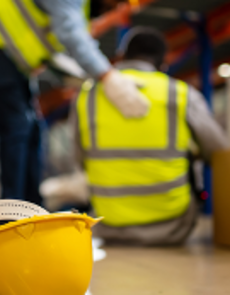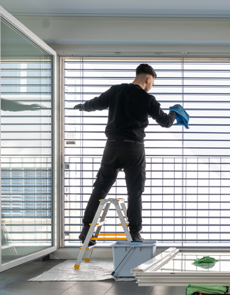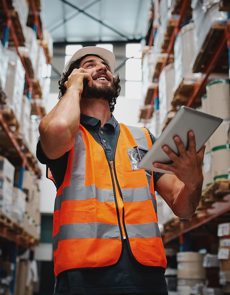Health and safety training for cleaners
Provide expert-led, engaging health and safety training for cleaners with our accredited health and safety eLearning courses.
This extensive health and safety training for cleaning staff is part of the most comprehensive library of RoSPA-accredited and CPD assured online health and safety courses in the UK.
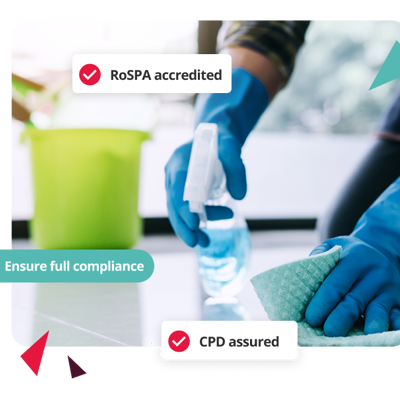
What is health and safety training for cleaners and why is it important?
Those who work in the cleaning industry can be exposed to a range of different risks and hazards, from things like occupational dermatitis to musculoskeletal disorders.
According to HSE’s most recent statistics, slips trips and falls account for 32% of non-fatal accidents at work, making them the most common hazard in the workplace.
Not only does health and safety training for cleaning staff help ensure the safety of cleaners, it helps ensure the safety of others, increases efficiency and improves employee satisfaction.
Our health and safety training course for cleaners is delivered through bitesize modules, available online and via the app to make training accessible and timely to complete.
This course covers an extensive range of health and safety topics that are highly relevant and crucially important for cleaning staff to understand to ensure their safety and the safety of others.
How this training for cleaners works
- RoSPA accredited and CPD assured Our health and safety training for cleaners is RoSPA accredited and CPD assured, ensuring the training is always up to date and your business stays compliant.
- Accessible via multiple devices Training is delivered via desktop or mobile for cleaning staff in multiple locations and can be accessed at any time to fit around busy schedules.
- Available immediately to new starters New cleaning staff can immediately get up and running with their training to allow scaling cleaning businesses to ensure new staff are appropriately trained and compliant as soon as possible.
- Broad range of topics Our health and safety training for cleaners covers a huge range of topics in detail, from asbestos awareness to slips, trips and falls and is designed to be appropriate for all businesses and cleaning staff.
- Ensure full compliance Our training includes checklists and evaluations to ensure cleaning staff are appropriately trained and fully compliant before they enter the workplace.

Schedule your personalised demo today!
Choosing the right training for cleaners
Health and safety training provided for cleaners should be broad enough to cover the range of hazards cleaners are exposed to, but comprehensive and specific enough to cover the key areas in enough detail to provide adequate and engaging training for cleaning staff.
Comprehensive health and safety training for cleaning staff should include:
- Chemical hazards training Training on how to manage hazardous substances, including guidance on adherence to COMAH, GHS and COSHH regulations where appropriate
- General Workplace safety General workplace training should be provided such as guidance on slips, trips and falls, first aid and manual handling, for example.
- Management support Adequate training should be provided for management and supervisory staff on accident management, investigation and reporting, risk assessments, health and safety auditing and lone working support, for example, to ensure the safety of cleaners in the workplace.
- Specialist environments training Cleaning staff often work in a variety of specialist environments, meaning adequate training covering a wide range of working environments should be provided to ensure their safety in the workplace.
Our accredited and wide-ranging health and safety cover all these important areas in more to provide appropriate and effecting training for cleaning staff.

Explore five essential health and safety tips for cleaners
Why use Access Learning for Cleaning training?
- Credible content – our courses are accredited, endorsed and designed in partnership with subject matter experts.
- Multi-platform learning - optimised for mobile and tablet, meaning less text and more engaging, easily accessible content.
- True ‘bitesize’ microlearning – making your learning experience more manageable, efficient and relevant.
- Learning pathways - split courses up into digestible topics to make it quicker and easier to find training in the flow of work.
- Accessible - we are working to make our content more accessible and are designing content with reference to the Web Content Accessibility Guidelines.
- Updated and refreshed – Access Learning courses are regularly updated ensuring the most up to date and compliant content.
Courses related to Health and safety training for cleaners

COSHH Training
Hazardous substances can threaten short or long-term health and pose a real risk to cleaning staff.
This course helps learners understand safe handling and use of hazardous substances that could harm cleaners and those around them.

Slips, trips and falls
Slips, trips and falls pose a risk to everyone, but particularly to cleaning staff who work regularly with spills and slippery surfaces.
This course helps learners identify where slips, trips and falls could occur before they happen, helping them understand the main causes and how to prevent them.
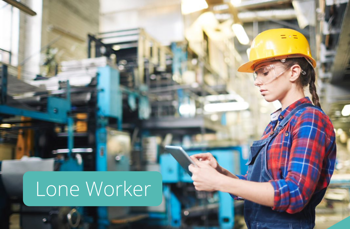
Lone Working
Often cleaners are required to work alone, and understanding the risks involved is crucial.
This course explores lone working in-depth, the related safety measures that can be put in place and the importance of controlling any risks, all of which are highly appropriate for cleaning staff.
FAQs
Here's a few frequently asked questions
Do cleaners need COSHH training?
The Control of Substances Hazardous to Health (COSHH) Regulations 2002 require that employers do everything within their power to ensure employees have the information, instruction and training they need to stay safe at work.
Simply providing the information needed to employees isn’t enough to meet the requirements of the legal directives set out by COSHH. Employers must ensure employees understand the information to ensure it helps adequately protect employees from health and safety risks in the workplace.
This is where an engaging and extensive course like our health and safety training for cleaners can help.
By providing the right content in the right manner, not only does this ensure the protection of employees but the peace of mind of the employer too.
Do learners get a health and safety certificate upon completion?
Learners gain CPD hours as they complete their training, while courses and modules are marked complete as learners work through their training. Learners also get a certificate at the completion of their training courses.
What training should cleaning staff have?
Simply adhering to the requirements of COSHH isn’t always enough to ensure the safety of cleaning staff.
Cleaners should have training that spans multiple applicable topics such as:
- Chemical hazards training Training on how to manage hazardous substances, including guidance on adherence to COMAH, GHS and COSHH regulations where appropriate
- General Workplace safety General workplace training should be provided such as guidance on slips, trips and falls, first aid and manual handling, for example.
- Management support Adequate training should be provided for management and supervisory staff on accident management, investigation and reporting, risk assessments, health and safety auditing and lone working support, for example, to ensure the safety of cleaners in the workplace.
- Specialist environments training Cleaning staff often work in a variety of specialist environments, meaning adequate training covering a wide range of working environments should be provided to ensure their safety in the workplace.
What are the legal requirements for a cleaning business?
There are many legal requirements cleaning businesses must adhere to, and arguably the most important set of regulations are The Control of Substances Hazardous to Health (COSHH) Regulations 2002.
It is required that businesses adhere to these regulations, ensuring cleaning staff thoroughly understand the risk of handling hazardous materials and substances to ensure the safety of themselves and others.
There’s also the ISO 45001 Health and Safety certification cleaning businesses may consider, which ensures businesses have in place a robust health and safety management system to manage risks, prevent accidents and meet legal obligations.
Other things like workplace policies, risk assessments and the correct legal agreements between parties involved with the cleaning business help to keep safety standards to a maximum.
Having expert legal advice on hand is crucial, along with the right health and safety training for cleaners, helping the cleaning business adhere correctly to any legal requirements.
Our Special Environments courses
Drive a safety culture with Access Learning

Download our brochure
Our eLearning course catalogue lets you explore our extensive RoSPA assured Health and Safety content.

Speak to an expert
Chat with one of our learning experts and find out how our Health and Safety courses can help your organisation remain safe and compliant.

Schedule a live demo
Explore the features, functionality and benefits Health and Safety courses has to offer and ask questions to our learning experts.






